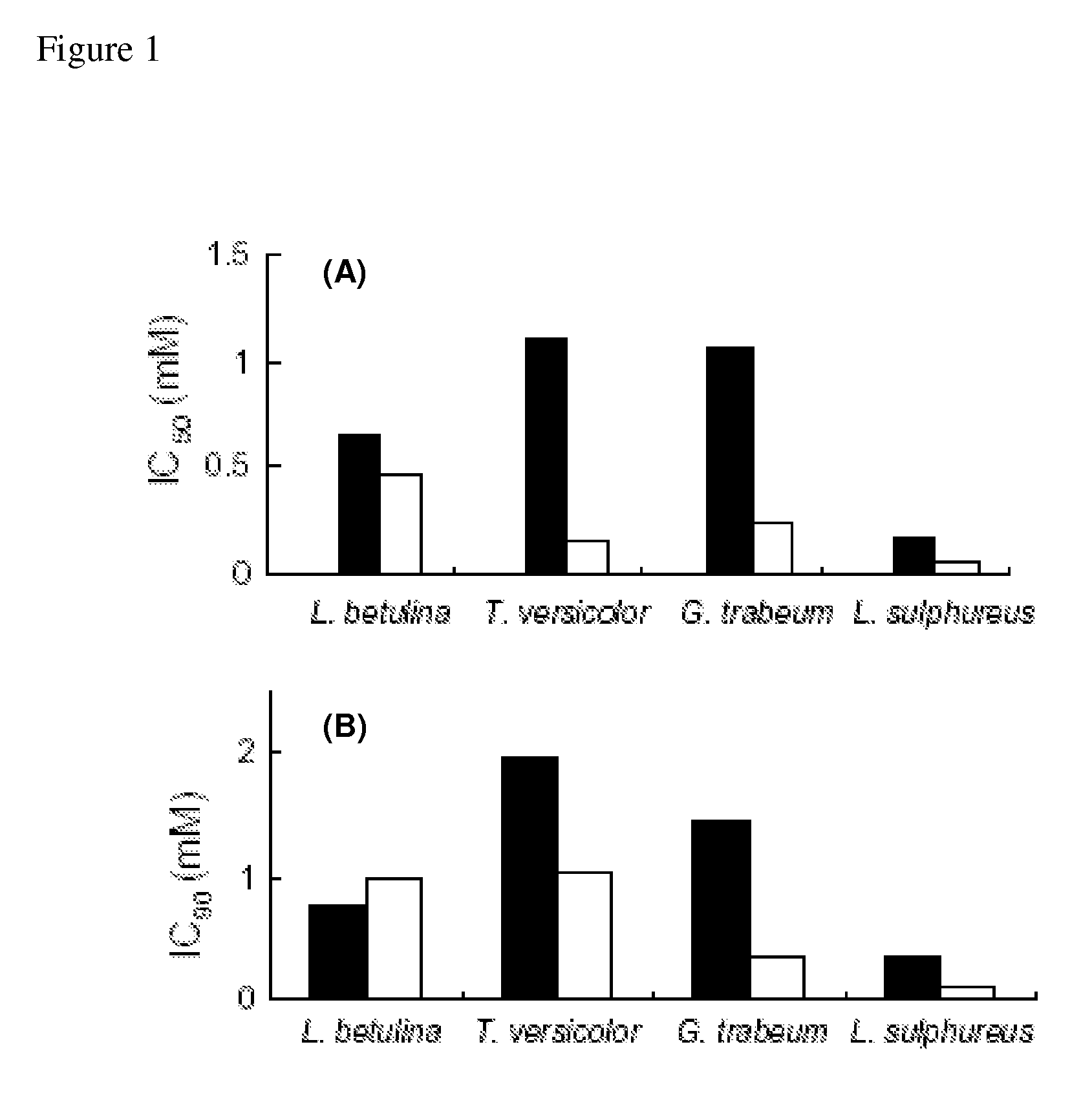Antifungal Compositions for Inhibiting Growth of Wood Decay Fungi and Use Thereof
- Summary
- Abstract
- Description
- Claims
- Application Information
AI Technical Summary
Problems solved by technology
Method used
Image
Examples
example 1
Anti-Fungal Activity of Antioxidants (Propyl Gallate, Octyl Gallate and Butylated Hydroxyltoluene) and Cinnamaldehyde
Fungal Strains
[0036]Fungal strains used were two white-rot fungi: Lenzites betulina (BCRC 35296) and Trametes versicolor (BCRC 35253) and two brown-rot fungi: Laetiporus sulphureus (BCRC 35305) and Gloeophyllum trabeum (BCRC 31614).
Chemicals
[0037]Propyl gallate and octyl gallate were purchased from Tokyo Kasei Kogyo Co. (Japan). Butylated hydroxyltoluene (BHT) and 1-diphenyl-2-picrylhydrazyl (DPPH) were purchased from Sigma Chemical Co. (America). Cinnamaldehyde was purchased from ACROS (Belgium). Commercial fungicide propiconazole was used as a positive control.
Media Preparation and Growth Condition
[0038]Potato dextrose agar (PDA) was mixed with distilled water at a concentration of 39 g / l and then autoclaved. Various chemicals such as propiconazole, propyl gallate, octyl gallate and cinnamaldehyde were dissolved in ethanol before adding into autoclaved PDA media.
[00...
example 2
Antifungal Activity of Octyl Gallate Alone
[0043]The strains used in this experiment include soft rot fungi [Chaetomium globosum (BCRC31605)], Cu tolerant rot fungi [Wolfiporia extensa (BCRC36022), Poria placenta (BCRC36412)], brown rot fungi [Laetiporus sulphureus (BCRC35305), Gloeophyllum trabeum (BCRC31614), Formitopsis pinicola (BCRC35303), Antrodia taxa] and white rot fungi [Lenzites betulina (BCRC35296), Trametes versicolor (BCRC35253), Schizophyllum commune (BCRC35258)].
[0044]The antifungal index (AI %) and median inhibition concentration (IC50) were measured as described before.
[0045]As shown of AI value in Table 2 and IC50 value in Table 3, at the concentration of 100 μg / ml, octyl gallate could inhibit the growth of C. globosum and A. taxa completely, while showing 75˜96% inhibition against W. extensa, P placenta, L. sulphureus, G. trabeum and F. pinicola. Octyl gallate also showed 41˜69% inhibition ability against L. betulina, T versicolor and S. commune at the concentratio...
example 3
Synergistic Antifungal Effects of the Combination of Octyl Gallate with Cinnamaldehyde
[0046]Antioxidants combined with cinnamaldehyde were studied to determine whether the combination has enhanced actions against wood decay fungi. The antifungal index (AI %) was calculated as described above. As shown in FIG. 2, the tested fungi were L. betulina (A) and G. trabeum (B). Octyl gallate (OG) and / or cinnamaldehyde (Cin) were used to treat wood decay fungi in various combinations. Cin50 indicated the concentration of cinnamaldehyde was 50 μg / ml, and OG25 indicated the concentration of octyl gallate was 25 μg / ml.
[0047]The antifungal index of cinnamaldehyde against L. betulina at the concentration of 50 μg / ml was 6% and that of octyl gallate against L. betulina at the concentration of 25 and 100 μg / ml was 16% and 42%, respectively. The antifungal index for the treatment using the combination of cinnamaldehyde with octyl gallate was greatly increased to 64% and 100%, respectively, indicating...
PUM
| Property | Measurement | Unit |
|---|---|---|
| Molar density | aaaaa | aaaaa |
| Molar density | aaaaa | aaaaa |
| Molar density | aaaaa | aaaaa |
Abstract
Description
Claims
Application Information
 Login to View More
Login to View More - R&D
- Intellectual Property
- Life Sciences
- Materials
- Tech Scout
- Unparalleled Data Quality
- Higher Quality Content
- 60% Fewer Hallucinations
Browse by: Latest US Patents, China's latest patents, Technical Efficacy Thesaurus, Application Domain, Technology Topic, Popular Technical Reports.
© 2025 PatSnap. All rights reserved.Legal|Privacy policy|Modern Slavery Act Transparency Statement|Sitemap|About US| Contact US: help@patsnap.com



